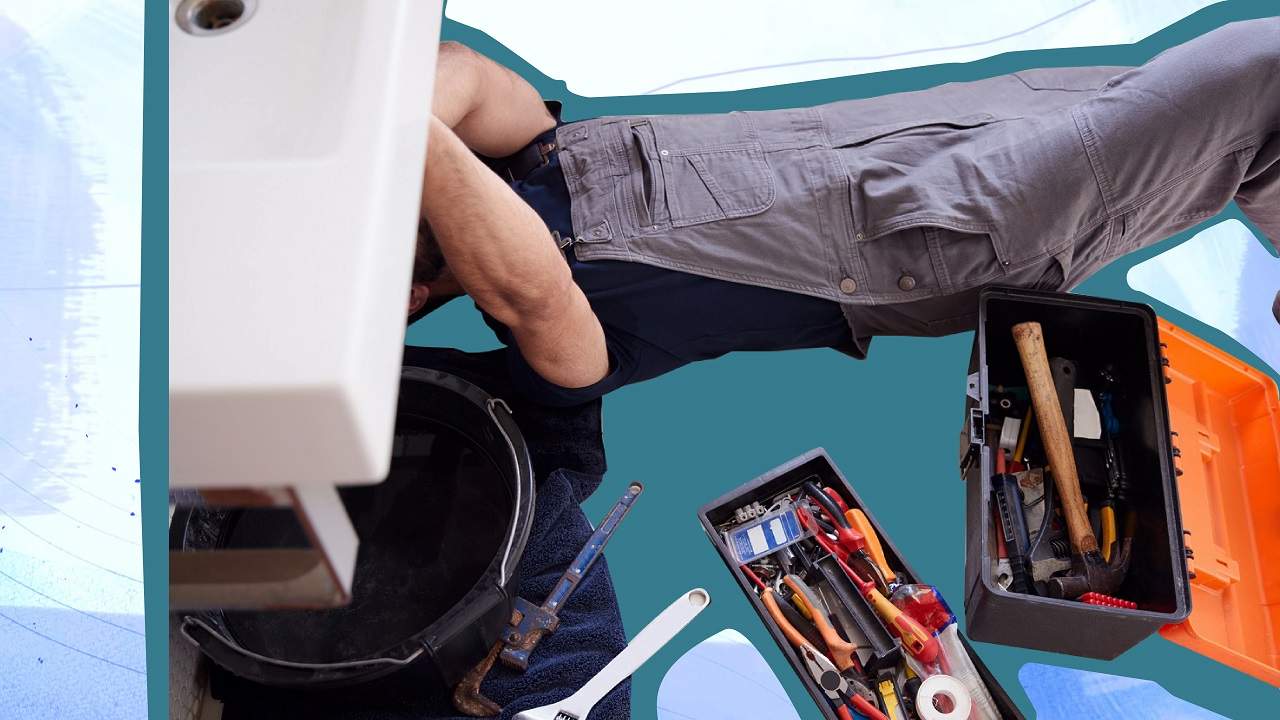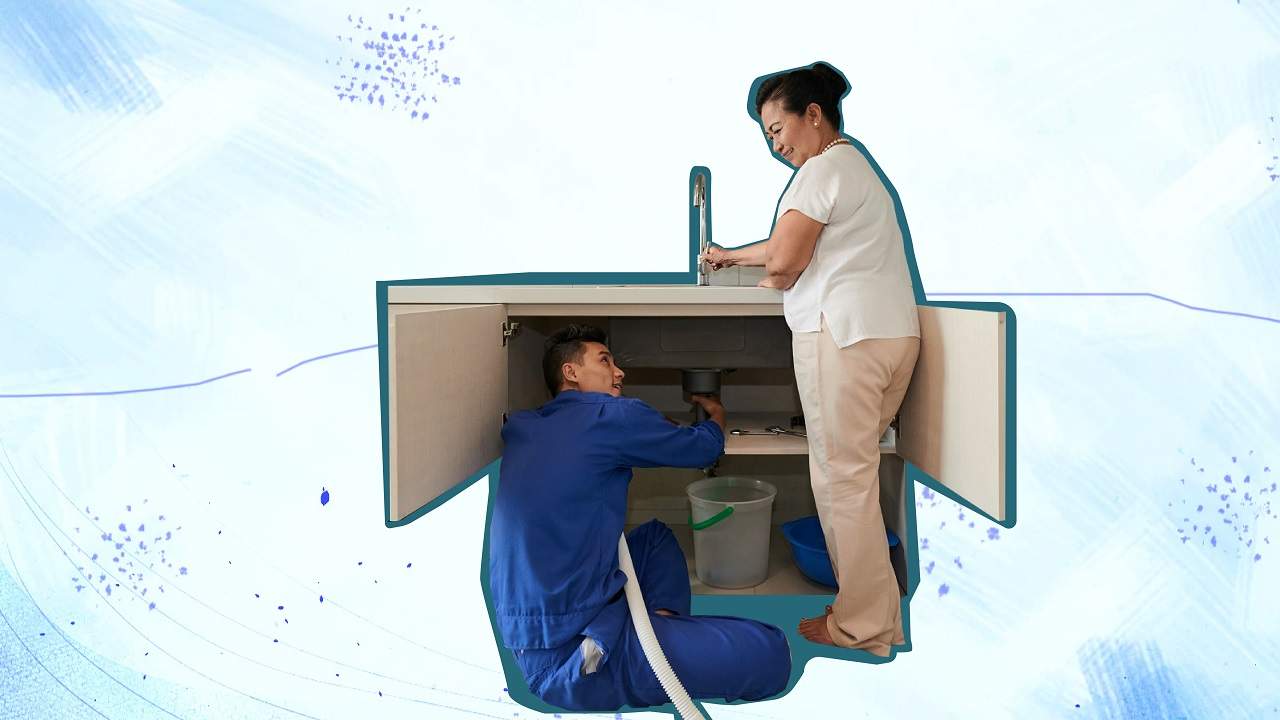You may use a thermal leak detection kit to find a sink leak, or rather just look for signs of a leak, such as water damage under the sink.
And once you spot these signs, you can use some DIY fixes to prevent further damage. So, today, we will tell you all about the various ways of fixing a leaking sink using temporary patching methods and mending faulty pipe connections.
We will also give you the deets on replacing the P-trap, sink strainer, and the other plumbing components usually responsible for sink leaks. Read on to find out!
4 Ways To Fix A Leaking Sink

1. Temporary Patching Of Leaks
The first method to fix your leaking sink is to patch the leaks temporarily. It’s more of a quick fix rather than a long-term solution.
The steps to patch the leaks temporarily are as follows:
A. Seal With Epoxy Putty
You can seal the leak for the moment by applying some 2-part epoxy putty.
A 2-part epoxy putty comprises two components; a soft base and a hardener. To mix the putty, combine the two components and knead them thoroughly until they’re one. When the components are mixed, the hardener solidifies the putty around the areas you apply it.
Once the plumber’s putty is formed, take the required amount and press it onto the leaking pipe. After application, leave the putty to harden and cure. The time it takes to cure will usually be mentioned on the putty packaging.
A 2-part epoxy putty is available at almost all hardware stores, and it can be used for most, if not all, types of pipes. However, keep in mind that these putties only temporarily stop the leak and are not a permanent solution for your leak troubles.
B. Self-Securing Tape
The second way to temporarily fix the leak is with the help of some self-securing tape. Silicone tapes are meant for low-flow leakages and would work efficiently in temporarily stopping the overflow of water from your pipes. These tapes can come in handy if you have a minor leak, no matter the material of the pipe.
To apply the tape, pull it tightly and wrap it around the area of the pipe or trap bend that’s leaking. Keep wrapping while you overlap each progressive piece underneath the new piece. You can stop wrapping when you feel the leak is secure and the plumber’s tape has formed a tight seal.
There’s no need to worry about glue residue from the tape on your pipe. Silicone tapes do not stick to your pipe but rather to themselves, which makes removing them relatively easy.
C. Attaching A Pipe Clamp
A pipe clamp will be helpful if the leak is located in the middle of the pipe or near the connections underneath the sink. These clamps have a flat rubber piece, called the gasket, and a metal fastener. The fastener attaches itself around the pipe.
Do keep in mind to get a clamp that is the right size and would fit your pipe, or else the seal will be flimsy.
To fix the clamp, press the rubber gasket firmly over the area of the pipe that is leaking. Proceed to fix the clamp on top of the gasket and secure it firmly around the leak. You can tighten the clamp by using a pipe wrench.
Like the other two options, clamps, too, work for different kinds of pipes. However, they are limited by the area they’re used in. They do not sit well on joints, curves, or any place even with a slight bend.
2. Leaking Pipe Connections
Oftentime, drain leaks may be due to faulty pipe connections, fixing which can resolve the issue. Here are a few fixes for these connection leaks:
A. Slip Nuts
The most prominent culprit when it comes to flimsy or loose connections is a loose slip nut. If you’ve noticed that your pipes are leaking at the joints, tighten the slip nuts to prevent further leaking.
Slip nuts are round fasteners used to secure the area where one pipe connects with another. To fix the issue of a loose nut, find the initial skip nut that connects a vertical pipe to your drain. Fasten it by turning it counterclockwise. After you’re done with the first nut, work your way down to the rest of the pipe.
However, keep in mind not to overturn the slip nuts when tightening them, as they can be prone to damage. Once you’re done securing the slip nuts, you can open the tap and let some water run. If you still spot a leak, you can try tightening the slip nuts once more with a pair of pliers.
B. Rubber Gaskets
Your pipes have little rubber rings called gaskets at the connections that form a watertight seal. But with time, these gaskets can develop wear and tear.
To replace them, unscrew the pipe’s slip nuts and pull out the gaskets. Check the gaskets for any damages. If you notice that the gaskets have developed cracks, immediately replace them with new ones that are the same size. Gaskets usually have two ends- a wide and a slim. Push the slimmer end of the gasket into the pipe.
You may also find gaskets within the slip nuts, which too, can be easily replaced by sliding it directly into the pipe. Just keep in mind to attach the narrow end of the gasket to the drain pipe that connects to your bathroom or kitchen sink.
C. Plumber’s Tape
Plumber’s tape is Teflon tape meant specifically for plumbing-related usage. These tapes can come in handy if your pipes are made of metal to create a watertight seal at the areas where the pipe connects.
Simply unscrew the portion of the pipe connection that has the leak by taking off its nearest slip nuts. Proceed to wrap the plumber’s tape here using a clockwise motion, with each rotation overlapping half of the previous wrap width. Once you’ve wrapped it securely, cut the tape off and screw the slip nut back on.
Here are a few things to keep in mind:
- Avoid putting the tape on counterclockwise
- Do not use the tape on plastic or PVC pipes
3. P-trap Replacement

A P-trap is the J-shaped bend under the bathroom sink that stops any sewer gasses from making its way into your home. Over time, the P-trap can wear out with use, which then causes it to leak.
In such a case, we’d advise replacing it immediately by following the steps listed below:
A. Preparation
Replacing a P-trap can be a messy job. Since there are chances of residual water being present in the trap, it is best to set something under it to catch the water.
Setting up a bucket or an old pan or tray underneath the bathroom sink can help prevent any water from dripping on the floor. Once you’ve placed the bucket, release the water from the P-trap. Some traps may have a valve at the bottom that can be screwed off to drain the water out. Turn the valve in a counterclockwise direction until water starts spilling out.
B. Unscrew Slip Nuts
The P-trap will be connected to the rest of the pipe with round slip nuts. Unscrew these slip nuts by rotating them clockwise to loosen them. Make sure not to turn on the faucet once the slip nuts are unscrewed, as the water will then spill on the floor below.
C. Purchase New P-trap Kit
Get a new P-trap that’s of the same size and material as the existing one. You can also choose to get P-trap kits, which contain all the necessary items to install the trap, such as pipes, gaskets, slip nuts, etc.
D. Assemble The Pipe
Start the assembly process with the most extended section of the pipe. Use it to connect the p-tap directly to the sink drain line by holding it against the bottom of the drain. Once placed correctly, attach the slip nuts and turn it counterclockwise to fasten it. If your pipe kit has a washer or a gasket, place its narrow end inside the drain before attaching the slip nuts.
Once you’ve attached this, attach the trap arm to the wall. A trap arm is a small pipe with a right angle. Take the broader end of a gasket, attach it to the straight end of the trap arm, and slide it into your wall drain pipe. Secure the trap arm by attaching the slip nuts and fastening them.
Add the remaining gaskets onto the exposed ends of both attached pipes and fit in the new P-trap. Screw the slip nuts in and tighten them firmly. Your new P-trap is successfully attached!
To test the installation, turn on your tap and let the water run down. Be sure to look out for any water dripping, and if there’s any, tighten the slip nuts in that area with a pair of pliers.
But if the leak is from the area that connects the pipes to your bathroom sink, it could be a sink strainer issue.
4. Sink Strainer Replacement
A sink drain strainer is a filter-like device that prevents any food or other non-liquid matter from getting through your pipes. But a damaged or broken sink strainer can lead to leaks. And you would need to replace the strainer to fix these leaks. Let’s take a look at how:
A. Disconnect The Pipe
Once you’ve located your bathroom sink drain strainer, proceed to disconnect the pipe right below the sink strainer. This is usually the vertical pipe that connects to your sink. Loosen up the slip nut connecting this pipe by turning it counterclockwise. If you experience trouble with detaching the slip nuts, get a pair of pliers for the purpose.
B. Remove The Locknut
A locknut is usually a large hexagonal fastener made with metal or plastic, which holds the drain strainer against the bottom of the sink. Use a pair of channel locking pliers and grip the locknut firmly. Now, turn it in a clockwise direction to loosen it and eventually detach it from the sink.
Once the sink strainer is exposed, grab and pull it out of the pipes. If the sink strainer is attached with screws, use a screwdriver to detach it from the pipes.
C. Purchase New Sink Strainer
The next step is to get a new sink drain strainer. There are many kinds of strainers available on the market, so ensure you get a compatible sized one. Getting a strainer similar to your old strainer will eliminate the possibility of any future problems.
D. Assemble The Strainer
First, clean the area thoroughly to assemble the strainer onto the sink. If there is any remaining old plumber’s putty, wipe it off with a clean paper towel.
Once the surface is clean, use some new plumber’s putty to make a rope and apply it to the drain hole. This creates a watertight seal around the hole.
If the strainer has multiple pieces, separate them and align the top piece with the drain hole. Push the piece down firmly into the plumber’s putty. Make sure there are no spaces or gaps between the strainer and the bathroom sink. Once the strainer is in place, wipe off any excess putty around the strainer.
Attach the locknut to the bottom of the strainer and tighten it firmly. Ensure that the locknut is secure by using a pair of channel-locking pliers. It would be best to use pliers to hold down the strainer from the top while tightening the locknut to keep it in place.
You can now attach the drain pipes to the bottom of the strainer and screw the slip nut. Turn the slip nut in a counterclockwise direction to tighten it. Finally, you can test the installation by letting the faucet run for a few minutes.
If nothing else works, the faucet may be at fault. So, try fixing the leaking faucet by tightening its bolts and gaskets. Alternatively, you may have to clean it thoroughly or get it replaced altogether.

How To Fix A Leaking Sink Conclusion
With that, it’s time for us to say goodbye!
Do keep in mind to turn off the water supply valve before you begin fixing the leak. This will avoid any further mess. And most importantly, be sure to test the drain after you have fixed the leak to ensure that it is functioning properly. The last thing you would want is to work hard only to create a bigger issue!
If you found this guide helpful, check out our article titled “how to fix a leaking radiator.” And we will see you next time!


